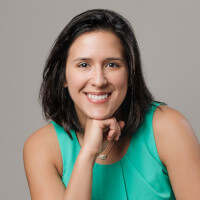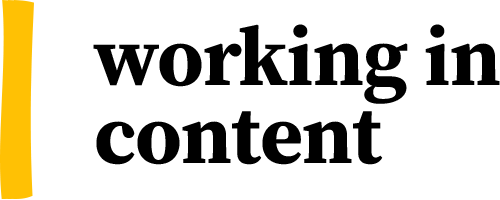Content strategy is a great career path. But what exactly does a content strategist do? Summed up, the role of a content strategist is to establish and execute a strategy to guide content activities and decisions that meet business and user needs.
There's a huge demand for content strategists today, and it's growing. Currently, 60,000 people have the job title Content Strategist on LinkedIn. And there are 1,278 roles worldwide open to candidates.
What is a content strategist?
A content strategist is a professional who plans, develops, and manages content initiatives to meet business goals and user needs. They establish the strategy for creating, delivering, and governing content across digital platforms. Content strategists combine analytical and creative skills to ensure content is valuable, purposeful, and effectively reaches its intended audience.
To start out a career in content strategy, you need to have experience in a content-related role for around 5-6 years, and usually a related university degree.
But those looking to make the jump are often left wondering how to get there. Who's hiring content strategists? What skills do you need? What does a typical day look like? How and where can you upskill yourself?
To help, we've created the ultimate guide to answering the question 'what does a content strategist do?'
You can follow the guide through, or jump to the section you need (here are the job description examples from Facebook, Tesla, Microsoft, plus loads more).
Contents
In this guide, we unpack the world of content strategy, and what the role of a content strategist entails. We'll look at:
Overview
- The complexities of content strategy
- Content strategist responsibilities
- Salary and career progression
- Challenges
- Key skills
Content strategy in action
- Analysing job descriptions
- Breaking into content strategy: advice from professionals
- A day in the life of content strategist
Resources
- Courses and educational programs
- Content strategist's library
- Content strategist's toolkit
- Online communities and groups
- Conferences
The complexities of content strategy
Before we tackle what a content strategist does, let's first talk about the complexities of content strategy. Things like defining it, and variations in job titles.
Defining content strategy
Content strategy is a relatively new and rapidly evolving field. This means there are lots of budding ideas and confusion around terms in the industry (sometimes with heated debates).
When it comes to defining content strategy itself, it's entirely different to content marketing. However, there's definitely an overlap with things like content marketing, governance, management and content operations.
What is content strategy?
Content strategy is the practice of planning, creating, delivering, and governing content to achieve specific business goals and meet user needs. It encompasses:
- The planning and development of content to serve both business objectives and user needs
- Creation of frameworks for how content should be structured, formatted, and organized
- Development of governance systems for content maintenance and updates
- Establishment of workflows for content creation, review, and publication
- Guidelines for voice, tone, and style across different channels
- Methods for measuring content effectiveness and ROI
Unlike content marketing, which focuses primarily on promotion and audience attraction, content strategy provides the overarching framework for how an organization's content should function across all touchpoints. It answers not just "what content should we create?" but also "why are we creating it?", "how should it be structured?", "who is it for?", and "how will we maintain it?"
But while the content strategist's role will incorporate all of these things, and they do feed into one another, they are different entities.
Content strategy is about planning. And the definition that is pretty much de facto in the industry is from Kristina Halvorson, author of Content Strategy for the Web:

"Content strategy is the planning for the creation, delivery, and governance of useful, usable content."
Content strategy is an art and a science. To do it successfully, a content strategist needs to engage with and deliver for 1) the business 2) the users and 3) the stakeholders.
The business
Great content is crucial to any organisation's success, and can be 'make or break,' particularly on a website.

"The role of the content strategist is to develop a roadmap for how content can contribute to achieving defined business goals"
The users
A successful content strategy doesn't just focus on business needs, but user needs too. It is:

"an integrated set of user-centered, goal-driven choices about content [that] gets the right content, to the right people, in the right place, at the right time"
The stakeholders
Because content strategists are responsible for creating a unified content experience, they must be able to engage stakeholders. They need to determine the needs of the wider organisation and departments, work with other teams like marketing, design and product, and get senior leadership buy in.
Variations in job titles
Ultimately, content strategy will depend a lot on what you're trying to accomplish in an organisation. And what comes with this is a variation in job titles. As if life wasn't complicated enough!
Because the role of the content strategist is a high-level job, it often includes parts of other roles, or can be a mix of a few. Or it might be focused on a specific area of content strategy.
For example, user experience (UX) is a key part of content strategy, and content strategy is often for a product. Or it can be more focused on marketing and copywriting. These elements are often specified in the job title.
Or sometimes, companies just like to name the role slightly differently. Here are a few job titles we've seen:
- Content Specialist
- UX Content Strategist
- Product Content Strategist
- Global Content Strategist
- Senior Copywriter + Strategist
- Content Marketing Strategist
- Digital Content Strategist
- Content Strategy Manager
- Head of Content Strategy
Content strategist responsibilities
Content strategy is something of an art and a science, and content strategist responsibilities can vary between organisations. You could be the solo content strategist in your company, or you might be part of a content strategy team.
But to start, here are some key tasks and responsibilities you would expect to take on if you are a content strategist:
- Define key brand messages for content
- Create and communicate a content value proposition
- Establish content workflow, management and governance
- Create and disseminate content standards documents, such as style, tone of voice, and accessibility guidelines
- Prioritise, plan, deliver, promote and maintain content for multiple channels and audiences
- Brief colleagues and delegate content tasks
- Content project management
- Conduct stakeholder interviews
- Carry out user research and usability testing
- Create and work with audience personas
- Map content to stages in the user journey
- Perform content audits and keep a detailed and up-to-date inventory
- Carry out competitor analysis
- Identify gaps and opportunities in content
- Find opportunities to rework and reuse existing content
- Information architecture: Create content models, and give recommendations for taxonomy and metadata
- Optimise content in line with SEO best practices, carry out keyword research
- Create and manage editorial calendars
- Publishing to Content Management Systems
- Use analytics tools to monitor content traffic, engagement, leads and conversions after content is published
This is not an exhaustive list, but as you can see there is a lot to think about! Being a content strategist can be an exciting and varied role.
What does a content strategist do?
A content strategist plans, creates, and manages digital content to serve both business goals and user needs. Their role combines strategic thinking with hands-on content work - from conducting user research and creating content guidelines to managing content projects and measuring results. Content strategists are responsible for ensuring content is useful, usable, and unified across an organization's digital presence.
The role typically involves working with three key groups: the business (defining strategy and measuring success), users (understanding needs and crafting experiences), and stakeholders (coordinating teams and managing projects). Some content strategists focus on front-end strategy (user experience and content presentation) while others specialize in back-end strategy (content structure and systems).
At companies like Facebook, Tesla, and Microsoft, content strategists earn between $70,000-$170,000 annually, reflecting the role's strategic importance in modern organizations.
Two types of content strategist
Broadly speaking, there are two areas of content strategy. Front-end and back-end. Each of these require different mindsets. It's important to learn skills for both, but most content strategists develop one skill set or the other.
Anni Rockley at Content Marketing Institute explains the difference between the two perfectly in this diagram:

Front-end is about the user experience and user journey, focusing on how the content looks and feels for the audience or customer. It's thinking about personas, user needs and how you are going to consistently deliver content that serves those needs.
Back-end is more technical. It's thinking about content as data. It's how content is structured, scaled, stored and retrieved, and making recommendations for how to best use technology.
Content strategist job description
To better understand what employers look for in content strategists, let's examine job descriptions from leading companies. This will give you a clearer picture of typical requirements and responsibilities in the role.
SurveyMonkey
Their content strategist listing focuses on help center content and cross-team collaboration. Key requirements include:
- 2+ years of help center or knowledge management experience
- Strong editing skills for clarity and accessibility
- Experience with problem-solving and project prioritization
- Ability to give and receive feedback with empathy
TikTok
For their Senior Content Strategist (Help Center) role, they emphasize:
- Creating empathetic, clear messaging aligned with brand voice
- Collaborating with Customer Support and Product Operations
- Leading content audits and maintaining consistent narratives
- Experience with content management systems and workflows
Amazon
Their Seller University Senior Content Strategist position sets high expectations:
- 5+ years in content production or strategy
- Strong data analysis capabilities
- Experience developing training across various formats
- Program management experience with cross-functional projects
- Masters degree preferred in relevant fields
Looking at these job descriptions, we can see common themes emerge. All three companies prioritize candidates who can collaborate across teams, make data-driven decisions, and translate complex information into user-friendly content. They also consistently seek people who can handle changing priorities in fast-paced environments.
Want to learn more about what makes an effective content strategist job description and see detailed breakdowns of these examples? Read our comprehensive guide: How to Write a Content Strategist Job Description →
Salary and career progression
Content strategists are in high demand, and salaries can be impressive, with lots of room for career progression.
But a lot of this is dependent on the company, and the location (we also have articles by location for a more in-depth look at salaries in different cities and states).
As an overall average though, the starting salary for a content strategist is around $47,980 in the US. And, with big companies like:
- Facebook paying an experienced content strategist $128,761
- The average content strategist at Tesla earning $114,598
- Google paying up to $169,000 for a Senior Content Strategist and;
- Twitter paying up to $173,000
...it's definitely a lucrative career path!
Here's a breakdown of some general salary information based on experience in the US and the UK:
Content Strategist salary (US)
via Payscale
| Experience | Annual salary range | Average salary |
|---|---|---|
| Entry level | 33k - 70k | $46,960 |
| Early career | 40k - 80k | $54,539 |
| Mid career | 50k - 105k | $68,329 |
| Experienced | 56k - 132k | $81,599 |
| Late career | 66k - 148k | $100,362 |
| Experience | Annual salary range | Average salary |
|---|---|---|
| Less than one year | 31k - 115k | $49,000 |
| 1-5 years | 40k - 110k | $65,000 |
| 6-14 years | 54k - 141k | $87,700 |
| 15+ years | 65k - 180k | $110,000 |
via Glassdoor
| Experience | Annual salary range | Average salary |
|---|---|---|
| Middleweight | 49k - 101k | $70,175 |
| Senior | 61k - 125k | $87,642 |
Content Strategist salary (UK)
via Payscale
| Experience | Annual salary range | Average salary |
|---|---|---|
| Early career | 20k - 49k | £29,240 |
| Mid career | 41k - 69k | £49,510 |
| Experience | Annual salary range | Average salary |
|---|---|---|
| Less than one year | 15k - 44k | £28,000 |
| 1-5 years | 25k - 58k | £35,000 |
| 6-14 years | 32k - 103k | £56,000 |
via Glassdoor
| Experience | Annual salary range | Average salary |
|---|---|---|
| Middleweight | 27k - 73k | £38,570 |
| Senior | 45k - 58k | £50,431 |
Content strategist salary guide (late 2024)
Based on an analysis of over 300 content strategist job listings from Q4 2023 and early 2024, we've compiled comprehensive salary data to help both job seekers and employers understand current market rates. This guide covers entry-level to senior positions across various industries, including tech, healthcare, finance, and retail sectors.
According to our research, content strategist salaries can range from $43,888 to $267,000 annually, with significant variations based on experience level, location, and industry specialization. Here's a detailed breakdown:
ENTRY-LEVEL CONTENT STRATEGIST (0-2 years)
- Salary range: $43,888 - $90,000
- Average salary: $65,000
- Typical contract rates: $35-50/hour
- Required experience: 0-2 years
MID-LEVEL CONTENT STRATEGIST (3-5 years)
- Salary range: $80,000 - $160,000
- Average salary: $110,000
- Typical contract rates: $45-70/hour
- Required experience: 3-5 years
SENIOR CONTENT STRATEGIST (6+ years)
- Salary range: $98,000 - $267,000
- Average salary: $145,000
- Typical contract rates: $65-105/hour
- Required experience: 6+ years
LOCATION-BASED INSIGHTS
- Remote roles typically offer 10-15% lower salaries than office-based positions
- Hybrid positions often come with 5-10% higher salaries than fully remote roles
- Office-based roles command highest salaries but offer least flexibility
The content strategy field continues to evolve, with increasing emphasis on AI integration, user experience, and cross-channel content optimization. These trends suggest continued strong demand for skilled content strategists, particularly those with technical expertise and strategic planning capabilities. For professionals looking to maximize their earning potential, focusing on technical skills, leadership development, and specialized industry knowledge appears to offer the best path to higher compensation.
Challenges
Becoming a content strategist is a great career path, but not always an easy one. Content strategists face challenges on a daily basis, such as:
- Getting buy-in for content. Content is so important to the success of an organisation. But convincing C-level and senior leadership, as well as other teams of the benefits and value of content is often difficult.
- Getting a team together. Similarly, it can be hard to get leadership to invest in a solid content team. Content expert Rachel McConnell wrote the book 'Why you need a content team and how to build one'. And, in this interview with GatherContent she says:

"I wrote the book because I wished it was the book I'd had to give my boss when I was trying to grow a content team. It was so hard to explain what the different nuances were between content roles and why I needed a content manager and a strategist and a content designer. It was hard to get buy-in for more resource."
- Being involved early in projects. Often, content isn't put first in projects, which can lead to problems later down the line. Rachel goes on to say in the interview:

"We get stuck in this cycle of not being included early enough on projects, not being able to demonstrate value, so being under-resourced, so not being included early enough, and so it goes on."
- Wrangling stakeholders. The content strategist is in the unique position of making sure everyone in the organisation working on content is also working towards common goals. It can be hard to get everyone on the same page, particularly if your organisation isn't using the best tools and software for collaboration.
- Change management. There will be plenty of time where you'll need to challenge the status quo and manage change, for things like new processes and technology. As Hilary Marsh says in her article:

"Change management is often a significant effort, and takes lots of time and patience. People at different levels inside the organization need communications, mentorship, training, and reinforcement."
Key skills
There are a lot of skills, both around content but also people-oriented, necessary to tackle the challenges above. To work successfully, content strategists must have exceptional skills in:
- Organisation and task management. As you'll be planning and strategising content to execute over a long period of time, and managing schedules and deadlines, excellent organisation and task management skills are essential.
- Empathy and understanding. Being able to put yourself in the user's shoes, and understand their pain points, goals and journey - particularly when it comes to things like accessibility and usability - is crucial for content strategists. You also need to think from the perspective of the business, and different stakeholders.
- Data-driven mindset. You need to enjoy analysing and interpreting data, as this is a key part of content strategy. You'll need to back up your thoughts and ideas with clear data points.
- Storytelling. Connecting the dots between seemingly disparate things is a big part of content strategy. You'll need to be able to confidently present and tell stories with data to your team and clients. You also need to be able to create content that has an engaging narrative for the audience, in a way that resonates with their own story or journey.
- Collaboration. Collaboration is key to executing a unified content strategy. You need to be able to communicate your ideas well and understand stakeholders.
- Leadership. Often, what comes with creating a content strategy is the need for strong leadership, especially in change management. You'll often need to rally teams and convince people to adopt new ways of working, in line with goals and objectives.
- Multitasking, or wearing different 'hats'. While multitasking is not necessarily a good thing for focus, you will need to perform multiple, wide-ranging tasks and wear different hats in your role.
Content strategy in action
In this section we'll look at content strategy in action. We also interviewed experts for their advice on breaking into the field and overcoming challenges, and pulled together insights into the daily life of a content strategist.
Analysing job descriptions
We've done a quick analysis of some key parts of job descriptions from:
We've also added links to the full job descriptions if these are useful to have a look at.
To be a Content Strategist at Facebook, there's a big focus on collaboration with different teams:
"We're looking for a Content Strategist to partner with Facebook designers, product managers, researchers and product marketers to plan and create the content for Facebook products, continually improve that content, and evolve Facebook's voice and content standards."
They also emphasise sharing work and giving feedback.
You need to be proficient in a variety of areas for this type of role, and the description says:
"You're perfect for this role if you:
- Are versatile
- Love both high-level strategy and hands-on writing and editing
- Understand design thinking and user experience
- [Can] elevate the overall quality of our work."
They want somebody who can:
"promote content strategy at Facebook and in the broader community of design and content professionals in London"
and you get extra brownie points if you have experience with social products and information architecture.
As it's in tech, there is a strong focus on content for mobile or web, with this being a requirement for previous experience (with 5+ years in this specifically) and they have asked for:
"a link to samples of your work that show a breadth of experience across a range of content types. You may wish to show us content you've created for user interfaces, microcopy, user education, direct or transactional emails, style guides or product launch content."
Here is a link to the full job description.
This is an entry-level job description for Tesla and has the title 'Content Specialist.' It's classed as a Marketing, PR and Writing/Editing role.
"We are looking for a Content Specialist to join our growing digital team based in Fremont. This person will be responsible for producing, optimizing, publishing and maintaining high-quality content across our global websites, ensuring that visitors to our site have a seamless and positive user experience."
Again in this one, there's a focus on collaboration with other departments and teams such as:
"software engineers, product managers, business stakeholders [and] UX designers to produce and publish compelling content"
This is a hands-on writing and editing role, and candidates need to be able to:
"Ensure online content supports SEO goals, our brand standards, web style guidelines and legal and compliance requirements."
As well as being able to:
"Proactively manage content within the content management system and take ownership for quality and accuracy"
and
"Take the initiative to identify and propose new content."
They need somebody who can participate in the full web production lifecycle
"including scoping out content requirements, production, testing and ongoing management/refinement"
and data analysis:
"Incorporate learnings from analytics data into the development of content"
So, there are some strategic elements, but as it's entry-level, there's less focus on setting out things like strategic brand guidelines and governance policies.
Here is a link to the full job description.
This is a Senior Copywriter + Strategist job description for Microsoft's education video app Flipgrid.
It is fairly similar to Tesla's, with Strategist elements. Something like this could be a good entry-level role for a seasoned copywriter wanting to become a content strategist.
"We are looking for an experienced copywriter to manage and produce our written storytelling strategy in support of the Flipgrid community."
As this is a Senior copywriter role, candidates would be expected to be well-versed in content creation. There's a focus here on storytelling through copywriting, and social media.
They ask for somebody who can:
"act as both producer and strategist, with proven experience in owning copywriting projects from strategy to production."
There is a strong focus on experimentation and iteration, which is often a key part of a content strategist's role. Applicants need to have:
"A test and learn copywriting approach with the ability to first define goals then experiment, fine tune and iterate toward success."
Governance is also a key part of the role, with one of the tasks being to:
"Establish guidelines around brand voice to ensure consistency in all written communications while reviewing, editing and improving content written by others."
And suitable candidates need to already have proven experience in doing this "from the ground up."
Another key task is to:
"Help scale and mature our long-form community editorial practice for our newsletter and blog while identifying and executing new ways to amplify the stories we tell."
Strong communication, collaboration, presentation and leadership skills are also needed to "inspire team members."
Here is a link to the full job description.
Here's what a job description to be a Content Strategist for global marketing and advertising agency Ogilvy looks like:
"We are looking to hire a driven Content Strategist to develop and execute content strategies that drive traffic and generate leads."
Candidates need to have brand awareness and
"proven content strategy and project management experience."
However, they only ask for 3+ years experience, rather than 5+ which is what we usually see for a content strategist role.
This one has a big content marketing focus. Therefore, excellent analytical skills are needed. A key task would be:
"Analyzing content marketing data to identify trends and anticipate consumer needs. You should also be able to analyze user engagement metrics to determine whether content is well-received or not."
This one also has project management elements, with the role including:
"Delegating tasks to designers, writers and editors and providing feedback."
There's a focus on understanding trends, and being able to come up with innovative new ideas. They ask for somebody who can:
"Identify new internet trends and opportunities to spark conversation and potential content creation"
with a
"deep understanding of current and future digital trends across all platforms."
There's also a lot of high-level strategic work such as:
- "Establishing style guides that specify the writing style and tone needed to create engaging content.
- Performing content audits to assess how well existing content is performing.
- Performing content gap analyses to determine what type of content is missing and what is needed.
- Developing a solid understanding of the target audience through online and traditional market research."
Here is a link to the full job description.
Here is Mailchimp's job description for a Senior Content Strategist:
"We're looking for a Senior Content Strategist to join our growing team. The ideal candidate is a strong communicator with experience executing content strategies across digital media."
Again, like the others, collaboration with other teams is crucial in this role, with a focus on understanding and delivering for user and business needs:
"You will collaborate with marketing, research, design, and product teams to understand requirements, identify users' content needs, and align on business goals."
There is a lot of focus on classic strategic governance elements, such as:
- "Audit findings
- Sourcing plans
- Content types
- Template requirements
- Sitemaps
- Taxonomies
- Traffic analyses"
A data-informed approach to content planning is essential, and you'll need good presentation skills to communicate with team members and present findings to leadership.
As this is a Senior role, there is also a focus on leadership and inspiring your own teams here, where candidates will need to:
"Facilitate content critiques, lead workshops on topics like content design best practices and brand voice, and advise partners on content execution."
And
"Create tools, guides, and templates to empower colleagues to create their own great content and scale the discipline."
Interestingly, they say
"You have 5+ years experience as a content strategist, content marketer, writer or related position."
This means that you don't necessarily have to have had experience as a content strategist per se, but just a lot of experience in any content role.
Here is a link to the full job description
This is a job description for Senior Content Strategist at Lego. They start with:
"Looking to innovate and grow the awareness of the LEGO® brand across multiple digital channels? Become a Senior Content Strategist and bring your skills in crafting effective content to engage the users in more meaningful ways, and help give the content discipline a voice in the LEGO Group."
Now, this one has the same title as Mailchimp's above, but the core responsibilities are quite different. There are some overlapping skills needed to be a content strategist, but this one has a specific focus on social media strategy, and using social media.
Candidates will need to be switched on in terms of social media channels, with:
"A passion for social media and an excellent understanding of the leading platforms and the content that excels on them."
"A deep and thorough understanding of social media platforms and how they work, with a consistent record of having worked on and created content across multiple brands."
And
"The ability to stay ahead and move with platforms, reacting to changes in new technologies and formats."
An "instinctive" knowledge of what excels on platforms is also needed, which reflects the seniority of the role.
There are also general content strategy tasks and responsibilities, including:
- "Co-developing content pillars and models to aid creative."
- "Defining and presenting creative briefs and consumer/audience journeys into owned experiences"
- "Strong analytical skills and ability to interpret data to influence creative."
This job description also states that:
"It's an advantage to have a Bachelor's degree in Marketing, Media, Digital, Communications or similar"
but doesn't specify this as a 'requirement.'
Here is a link to the full job description
This job description for a Content Strategist at GOV.UK is in their guidance section, so it's not for any one specific job, but rather an example. However, it still gives a good picture of what government job descriptions might look like:
"A content strategist takes an overview of content and how it is produced. In this role, you:
- "design governance, workflows, and taxonomies in a user-centred context"
- "work with senior stakeholders, user researchers and content, service and interaction designers"
- "shape and structure the architecture of content based on user-centred design principles"
The UK Government Digital Service (GDS) are well-known for their forward-thinking approaches to content, and this is reflected in the focus on modern working practices like "agile" working (borrowed from software development, and now becoming a common practice in many organisation).
Candidates for this type of job role need to understand:
"Agile working. You know about agile methodology and can apply an agile mindset to all aspects of your work. You can work in a fast-paced, evolving environment and use an iterative method and flexible approach to enable rapid delivery. You are unafraid to take risks, willing to learn from mistakes and appreciate the importance of agile project delivery for digital projects in government. You can ensure the team knows what each other is working on and how this relates to practical government."
The job description also brings in other design elements like prototyping and content design. User-centered design is another term that crops up a lot in content strategy, and candidates will need to know how to apply:
"User-centred content design. You can design content to meet user needs and make complex language and processes easy to understand. You can understand and implement style and standards."
There's also a focus on stakeholders in this one, and managing relationships:
"Stakeholder relationship management. You know how to identify, analyse, manage and monitor relationships with and between stakeholders. You can communicate with stakeholders clearly and regularly, clarifying mutual needs and commitments through consultation and consideration of impacts while focusing on user needs. For example, you know how to manage customer and supplier relationships, ensuring that recommendations deliver maximum benefit and facilitating workshops with stakeholders."
Here is a link to the full job description.
Breaking into content strategy: Advice from professionals
There's some great advice out there on getting started with content strategy and breaking into the field.
In this section, we've put together some quotes from articles (along with some from our own interviews) from content experts and strategists reflecting on their roles and how they got there, with some real-world tips and advice.
Natalie Shaw has given some great advice and reflections on her career in her article on getting started in content strategy:

"Before joining Facebook in 2016, I had done things like graduate in law, work as a music journalist, and write some of GOV.UK's content on subjects like tax, benefits and immigration. The common strands were communication and simplicity; no matter the context, I realized I got a kick out of cutting through complex information in order to analyze it, develop patterns and communicate it back out to the world."
"If you work with words on the web or mobile devices, it's possible you already have some of the skills needed to be a content strategist. Or maybe you're learning them in school or in a different job. Like me, most content strategists don't start out in the role: we come from diverse backgrounds like journalism, UX design, technical writing, marketing, library science and a host of others."
3 tips for starting out:
- Every content strategist is different – think about your strengths
- Start to explore the world through a content strategy lens
- Hone in on people problems
There are more tips in the full article.
In her article on tips for mastering content strategy on the UX Collective blog, Erin Schroeder talks about how she came to realise content strategy was the right profession for her:

"When I finished graduate school for journalism in 2009, I was bound and determined to be a shoe-leather reporter. I saw myself, notebook in hand, getting the stories that mattered. At that point, I'd been a correspondent for a metro newspaper for five years, and only saw opportunity ahead. Move over, Lois Lane!
"But like many industries, journalism wasn't sure how to transition to the digital world. Meanwhile, I was struggling to stay afloat on a meager print newsperson's salary and long, grueling hours, all while also balancing a part-time job as an adjunct instructor at a local college. I decided to give my life some balance and move my writing experience into a more stable profession with growth ahead: Copywriting and website development.
"And I loved it.
"I loved thinking strategically, learning about what users expect, and watching the digital trends transform year to year. Eventually, I ended up where I am today as a content strategist for a local healthcare marketing agency."
3 tips for starting out:
- Follow the pros in the field
- Devour all things content strategy, content marketing and beyond
- Bookmark what you dig the most
More tips in the full article.
Hilary Marsh has established herself as a content strategy consultant, thought-leader, and community ambassador in the field. In an interview with Content Strategy Answers, and an article on her Medium site about content strategy life lessons, she shares:

"I started my professional career in magazine publishing and then was a copywriter. When I first discovered the Internet in about 1995, I thought my combination of editorial and marketing writing would be a good fit, but it was challenging to find anyone who was paying for content.
I moved from NYC to Chicago in 1997 and got a corporate job where I led their website redesign effort and helped create their first intranet. In 1999, I went to a conference in San Francisco – Web99 – where I first heard the term "content strategy" at a fabulous panel discussion with Molly Wright Steenson and other cool women. When I learned that it meant applying a publishing mentality to websites, I knew I'd found the name for what I'd been trying to invent.
Shortly after that conference, I started to see job postings for content strategists, and I got a job at Sapient, where there was already a thriving content strategy practice."
3 tips for starting out:
- Stay strong and forge on
- Learn from others
- Buy books and follow content strategy blogs
Read more in the full interview and article.
A day in the life of a content strategist
What can you expect in a content strategist role? What does it look like day to day in an organisation? What lessons have people learnt along the way? We've pulled together some interesting articles and quotes where content strategists reflect on their roles:
Marissa Phillips talks about content strategy behind the scenes at AirBnb, and how she collaborates with different teams early on in the product development process:

"We do our best work when we can get involved early on in the product development process. We sit by our designers to map out entire flows, agree on a hierarchy of information, and weigh different approaches to the design or content, and we use insights from research and data science to inform our recommendations.
We look to product managers to help us understand the problems we're solving and the information we need to convey to people using our products. We collaborate with engineers, bring in our legal team to review content from a policy lens, and work with language managers on our localization team to make sure our ideas translate well."
In this article, Kimmoy walks through what a product launch at Google is like, where she does a little bit of everything:

"Most of my days are spent editing and writing help center articles, in-product messages, user-interface text, and sometimes marketing content. I find myself referencing style guidelines often and asking my peers a ton of questions so that I'm staying consistent with the voice and tone of the company."
On the other hand, Alaine Mackenzie talks about specialising in product content strategy in this interview:

"We focus on all the words that go into Shopify products. We don't do marketing content, documentation, or social media – we plan and write interface content. Once a Shopify merchant signs into their store, we're responsible for communicating with them."
Jonathon Colman is now working at Intercom, but in this interview, he talks about what he learned in his role at Facebook:

"I've learned that "Quality" isn't a definition; it's a conversation. Our team uses a clear set of content principles – content should be Simple, Straightforward, and Human – with a strong set of standards in all of our work to ensure that we approach each new product from the standpoint of empathy for the user's experience.
I've also learned about the concept of "Ruthless Prioritization" because there's so much work for us to do and so much opportunity that we need to focus on just the top priorities or else we won't be able to succeed at our mission of connecting the world. I'm constantly asking myself: how can I best use the time given to me right now?"
In this interview, Hillary Marsh talks about her typical day:

"On a typical day, I might be talking to a client about a project we are working on together. Typically, in the early stages of a project, we're identifying what they want to get out of specific tasks, then in the middle, my team and I will be doing those tasks (content audit, comparative audit, stakeholder interviews, etc.), and then during the later stages of a project, we're working together closely to figure out their future structure and processes – governance, taxonomy, team structure and roles, etc.
In addition to client work, I might be doing a variety of other things – contributing to an online discussion about a relevant topic, submitting a proposal to speak at a conference, responding to a project proposal, setting up a meetup, or connecting with a prospective team member. I always need to keep an eye on community-building and planning for the future, while at the same time keeping my attention on the work I have now."
Erin Crews, Senior Content Strategy Manager at Mailchimp spoke to Typeform about what her role entails. Here's a bit about how they measure the success of content:

"We're always working on how to measure the success of content. Everything that we do should ladder up to high-level goals around customer acquisition, product adoption, and retention. But we'd almost never measure a single piece of content against goals like that.
What we look for are user behaviors that show a high level of intent to do that thing eventually---micro-conversions. We don't publish an inspirational customer story thinking it'll cause someone to sign up for our product. But we look at: does it cause someone to return to the site more frequently?"
Courses and educational programs
There are heaps of courses and educational programs out there to help you upskill in your content role and learn how to be a content strategist. Here are some we've found:
- MA in Content Strategy. FH Joanneum University, Graz, Austria
- MA in Digital Content Strategy. University of Kansas, School of Journalism and Mass Communications
- Storytelling and content strategy. Short online course - University of Washington's Professional & Continuing Education
- Content Strategy. Short online or in-person course - The Chartered Institute of Marketing
- Better content: Strategies to increase quality and effectiveness. One day program - Nielsen Norman Group
- Become a Content Strategist. Short online course - LinkedIn
- How to create a successful content strategy. Short online course - HubSpot Academy
Content strategist's library
Fill your boots! Here are the best content strategy resources to be armed with for career development:
Books
- Content Strategy for the Web. This is the go-to industry handbook by Kristina Halvorson.
- The Elements of Content Strategy. This is a short introductory book by Erin Kissane on what content strategy entails.
- Content Strategy: Connecting the dots between business, brand and benefits. This book by Noz Urbina and Rahel Anne Bailie talks about the value and ROI of content and how to develop a solid strategy.
- Content Everywhere. Written by Sara Wachter-Boettcher, this book looks at strategy and structure for future-ready content.
- The Accidental Taxonomist. Written by Heather Hedden, this is a comprehensive guide about the art and science of building information taxonomies. It's highly technical information in straightforward English.
- Harvard Business Review's 10 must-reads on change management. This is a great collection of HBR articles for an introduction to change management and change leadership.
- Content Strategy at Work. Written by Margot Bloomstein, this is a great book with real-world examples and case studies of content strategy in action.
- Lead With Content. This book by Padma Gillen is for content strategists that need to convince and convert their organisations about the value of user-centered content, and going content-first in digital transformation projects.
- Collaborate. By Ellen de Vries. This book for anyone with an interest in collaboration techniques for digital teams.
- Content Strategy for Mobile. This is an excellent book by Karen McGrane on adapting your content workflow for mobile devices.
Websites
- Web Content Accessibility Guidelines (WCAG). Accessibility is a big part of content strategy today, and the WCAG is the standard in regulations. It's dense, but a good thing for any aspiring content strategist to familiarise themselves with.
- Readability Guidelines. Put together by Sarah Richards at Content Design London, this is an excellent resource for content strategy. It's an award winning collaborative, global project on readability.
- Usability.gov. Usability is a key part of content strategy, and this website has everything you need, from key information to methods to templates.
- Plainlanguage.gov. Content in clear, plain, simple, easy-to-understand language is a really important part of content strategy. This website has everything you need
Webinars
- GatherContent host lots of webinars on content strategy. Here's one on how to position content as a business asset and get leadership buy-in.
- Here's another from Kristina Havlorson, which is a Q&A on Content Strategy for the Web.
Podcasts
- Content Strategy podcast. This is hosted by Kristina Halvorson, and is one of the best podcasts out there for those in content strategy.
- Content strategy insights. This is also a great podcast from Larry Swanson which covers lots of interesting stuff.
- Boagworld UX podcast. This is about UX design, but it also has lots of useful tips and episodes on content strategy.
Videos and recorded conference talks
- Content Strategy: A primer for beginners. This recorded talk from Katie Del Angel dives into the world of content strategy and is a lovely introduction to the field.
- Moz Whiteboard Fridays. This is a fun series of videos from Rand Fishkin at Moz which cover up-to-date SEO practices in bite-sized chunks.
- The intersection of content strategy and UX design. In this recorded conference talk, content expert Marli Mesibov looks at how content strategy and UX design work together.
- Content strategy career advice. In this interview, Jon Burkhart talks about industry terms, how audiences have changed, what they want, and key skills needed to survive as a content strategist.
- More career advice from a freelance content strategist. Alex Lemon gives tips and insights into her role and getting into the industry in this short interview.
- Telling strategic stories. This is a great talk from Britteny Dunkins at the 2018 Confab event on strategic storytelling.
For more, check out this epic list of content strategy resources by Jonathon Colman, or this content strategist's reading list from Brain Traffic, which includes lots of articles too.
Content strategist's toolkit
Going back to the responsibilities section at the top of this guide, it's good to familiarise yourself with some of the practical tools and templates used by content strategists if you're looking for a job in this area. Here are a few to help:
Apps
- Trello. For keeping lists, tracking tasks and organising projects.
- Readable. For checking the readability of content against things like reading age scores.
- Ahrefs. Great all-round tool for SEO which can help with audits, keyword research, gap analysis and more.
- Answer The Public. A visual way to see what people are searching online.
- Buzzsumo. See what content is posted by influencers, and what is performing well and getting shared.
- GatherContent. This is the go-to content operations platform for organisations that have a lot of content to deliver, and need to collaborate efficiently.
Templates
-
Digital competitive analysis template. This includes the elements of competitive analysis, and how to do it.
-
User journey map template.This will help you map what users are thinking, feeling and doing at each stage of their journey, so you can deliver the right content, in the right place, at the right time.
-
Content audit spreadsheet template. Audits can be difficult. This template has everything you need to get started with criteria and inventory.
Online communities and groups
There are lots of online communities that you should be getting involved in if you are serious about content strategy. Here are just a few:
Hilary Marsh has also put together this amazing list of content strategy meetups by location.
Conferences
-
Confab - Online everywhere. From UX to accessibility, structure to storytelling, Confab covers everything content strategy.
-
Boye - Aarhus, Denmark. The digital leadership conference.
-
Utterly Content - A global, online conference which brings together content strategists, content marketers, content designers and UX professionals.
-
Button conference - Online everywhere. This is a conference specifically designed for people in product content.
















